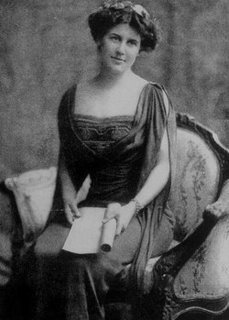Inez Milholland [1886-1916]
This never-to-be-forgotten leader comes to mind for many reasons. If you never met INEZ MILHOLLAND [1886 — 1916], war resister, suffragette, civil rights organizer, and human dynamo, then make her acquaintance here.
 • • Though it seems like yesterday that she was arguing the merits of her case in Jefferson Market Court, it took place almost 100 years ago on 18 January 1910.
• • Though it seems like yesterday that she was arguing the merits of her case in Jefferson Market Court, it took place almost 100 years ago on 18 January 1910.• • This is what the newspapers said about the trial in January 1910:
• • • MISS MILHOLLAND WILL APPEAL IF CONVICTED • • •
The cases of Miss Inez MILHOLLAND, daughter of John E. MILHOLLAND, and Lieut. Henry W. TOURNEY, of the Coast Artillery Corps — — who were arrested last night as the result of a demonstration by striking shirtwaist workers which Miss MILHOLLAND was leading — — were called in Jefferson Market Court, Manhattan, to-day, and after much testimony had been taken were continued until to-morrow afternoon.
• • Miss MILHOLLAND, accompanied by the lieutenant and 500 strikers and their sympathizers, were marching in Waverly Place in front of a factory when Police Captain HENRY demanded that they disperse. They refused, declaring that Magistrate BARLOW had declared so long as they kept moving they could not be disturbed. HENRY disputed this. He told the court to-day that the strikers and their followers blocked the streets and obstructed traffic. His uniform was badly torn in the melee which followed the refusal of Miss MILHOLLAND to order her followers to disperse and the [ . . . ] were badly ruffled because young women, in ignorance of the divinity that hedges the person of a New York police captain, demanded his number.
• • It is rumored that as the result of his coming into conflict with the civil authorities and being locked up — — both he and Miss MILHOLLAND were placed in a cell until John MILHOLLAND arrived to bail them out — — Lieut. TOURNEY may have to face a court-martial. In all, fifteen strikers and sympathizers were arrested last night.
• • Should the police prove their charge of disorderly conduct and obstructing an officer in the discharge of his duty against Miss MILHOLLAND the case will be appealed to the highest courts in order to get a decision on this question as well as to have determined how far a person may go on "peacefully picketing" a plant where there is a strike. Miss MILHOLLAND is a graduate of Vassar and an ardent advocate of women's suffrage. . . .
• • • • • • • • • • • • • • • • • • • • • • • • • • • • • • • •
• • Inez Milholland was born in Brooklyn, New York on 6 August 1886. She attended Vassar and was suspended after organizing a women's suffrage meeting in a cemetery.
• • She matured into a record-setting collegiate athlete, an attorney, a forceful and charismatic public speaker. Friends remembered Inez as a tall, beautiful woman in flowing robes, riding a white horse at the head of a great movement [March 1913]. She fought for labor, was a writer and magazine editor, served as a correspondent in the First World War, was jailed as a suffragette in England, and died at 30 while on a speaking tour as a suffragist in this country.
 • • Her last public words were, "Mr. President, how long must women wait for liberty?"
• • Her last public words were, "Mr. President, how long must women wait for liberty?"• • In 1913 Milholland led the women's suffrage demonstration in Washington on a white horse. Wearing white robes, the photograph of Milholland during the parade became one of the most memorable images of the struggle for women's rights in America.
• • Milholland lived in Greenwich Village [New York] and was associated with a group of socialists involved in the production of The Masses journal. [This group included Max Eastman, John Reed, Crystal Eastman, Inez Milholland, Louis Untermeyer, Randolf Bourne, Dorothy Day, Mabel Dodge, Floyd Dell, and Louise Bryant.]
• • Like most of the people involved with The Masses, Milholland was opposed to America's involvement in the First World War. In December 1915, Milholland and other pacifists travelled on Henry Ford's Peace Ship to Europe.
• • On her return to the USA she became one of the leaders of the Congressional Union for Women Suffrage. The movement's most popular orator, Milholland was in demand as a speaker at public meetings from coast to coast.
• • Inez Milholland, who suffered from pernicious anemia, was warned by her doctor of the dangers of vigorous campaigning. However, she refused to heed his advice and she collapsed in the middle of a speech in Los Angeles on 22 October 1916.
• • She was rushed to a hospital. Despite repeated blood transfusions — — blood donated by her sister Vida — — 30-year-old Inez died on 25 November 1916.
• • Jefferson Market Court commemorates this peace activist and suffrage martyr, and rejoices in her bright spirit as this troubled city prepares to go to the polls in November 2008, the sixth year of the wasteful war in the Middle East — — the US-led take-over in Iraq that has resulted in thousands killed.
• • Every New York City historian remembers our hometown firebrand Inez Milholland. In Greenwich Village, many daughters have been named in your honor.
__ ___
Source:http://jeffersonmarketcourthouseny.blogspot.com/atom.xml
Jefferson Market
• • Photo: Inez Milholland • •
NYC
New York Public Library
Jefferson Market.

Labels: 10011, 1886, 1916, Greenwich Village, Inez Milholland, Jefferson Market Court, New York, NY, The Masses


<< Home